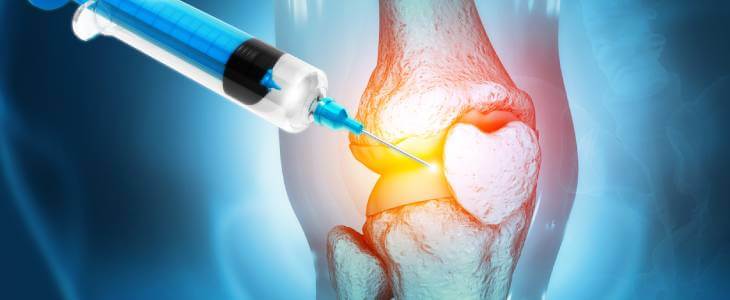Osteoarthritis is a big problem in the U.S., growing as the population ages. According to the CDC, over 50 percent of adults over 65 have been diagnosed with osteoarthritis. At Long Island Spine Rehabilitation Medicine, we treat a diverse group of patients with this disorder. As skilled physiatrists, we are committed to relieving their pain so they can move more comfortably through their daily routines and enjoy a better quality of life. For this purpose, we often administer corticosteroids.
To understand the vital part corticosteroids play in treating osteoarthritis, we have to understand what the disorder is and how it affects the lives of the patients who suffer from it.
What Is Osteoarthritis?
Osteoarthritis is a degenerative joint disease characterized by the gradual breakdown of cartilage in the joints. Since cartilage provides a cushion between bones, as it erodes through normal wear and tear, bones rub directly against one another, resulting in pain, stiffness, and restricted mobility. While the disease is irreversible, the injection of corticosteroids reduces inflammation, decreases pain, and facilitates movement.
For most patients who suffer from osteoarthritis, daily tasks become increasingly challenging and pleasurable physical activities become harder. Pain and stiffness may interfere with walking, climbing stairs, lifting heavy objects, even turning door knobs, or cutting vegetables. Such limitations interfere with the individual’s self-confidence and independence.
Risk Factors for Osteoarthritis
Some people are more prone to develop osteoarthritis than others. In addition to aging, risk factors include:
- Genetics
- Being female
- Joint injuries
- Repeated stress on the affected joint
- Obesity (putting more weight on the joints)
- Congenital defects (e.g. bone deformities)
- Certain systemic illnesses
How Corticosteroids Help With Osteoarthritis
Corticosteroids (also known as “steroids”) mimic the effects of natural corticosteroid hormones produced by the adrenal glands. These medications have strong anti-inflammatory properties, making them valuable in managing the symptoms of osteoarthritis by reducing inflammation in the affected joints, most commonly the knees, hips, back, neck, and hands. As inflammation recedes, swelling and pain subside, and as a result, patients regain some of their lost function, permitting increased mobility and restoring a sense of self-reliance.
How Corticosteroids for Osteoarthritis Are Administered
Corticosteroids can be administered in a wide variety of ways — orally, topically, intravenously, or through inhalation. Although in mild cases of osteoarthritis oral or topical corticosteroids may be used therapeutically, best results are typically provided by corticosteroid injections.
Our doctors are highly skilled and have extensive experience administering such shots, either as epidural steroid injections for the spine under fluoroscopic guidance or intra-articular joints under ultrasound guidance for other parts of the body. Such injections can help fight the heat, redness, pain, and swelling of inflammation relatively rapidly.
Time Frame for Effectiveness
For most patients, corticosteroid injections will provide relief within a few days and that relief may continue for three or more months. However, the effectiveness of corticosteroids in managing osteoarthritis varies from person to person. Individual differences among patients influence how quickly the medication starts working, how much impact it has, and how long its positive effects last.
Corticosteroid Injections Are Not Right for Everyone
Though frequently wonderful for those to whom they are administered, people who take blood thinners, have bleeding disorders, high blood pressure, type 1 diabetes, or glaucoma should not receive these injections. Also, women who are pregnant must avoid epidurals since the fluoroscopy used to guide the process could damage their unborn child.
Risks Involved in Corticosteroid Treatment
Corticosteroids are the fastest and most efficient way to control inflammation. The trade-off is a range of side effects, some quite serious. Possible side effects include:
- Decreased effectiveness of the immune system
- Adrenal suppression
- Joint damage (frequent injections into the same joint may lead to tissue damage and cartilage loss)
- Infection at the injection site (rare with proper sterilization)
- Temporary flare-up after injection (some individuals experience a temporary increase in pain and swelling following the injection, which usually subsides within a few days)
Moreover, high doses of corticosteroids administered frequently over a long period can lead to serious systemic side effects like weight gain, high blood pressure, mood changes, and osteoporosis. You can rely on our doctors to carefully monitor corticosteroid dosages and time frames to avoid such problems. Typically, we recommend that our patients receive no more than three or four injections a year.
Contact Our Osteoarthritis Specialists To Find Out if Corticosteroids Are Right for You
Our doctors are dedicated to relieving pain and restoring function. We have a track record of success helping patients who suffer the discomfort and frustration of osteoarthritis. Contact us to discuss our multiple nonsurgical methods to treat this condition and to learn whether corticosteroid injections are best for your particular case. The sooner you contact us, the sooner we can make your life easier, more productive, and more pleasant.
